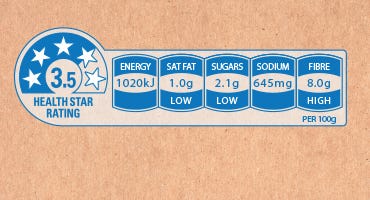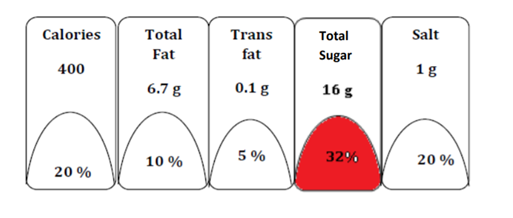A star rating for Chips and Chocolates?

In today’s Finshots, we talk about the Indian Nutrition Rating (INR) and the debate around it.
Also, a quick sidenote. If you're someone who's great with communication and are enthusiastic to join our team, Ditto is looking to recruit new Insurance advisors. And no you don't need to know about insurance. We will train you from scratch and you can enjoy working remotely with a great team. Click this link to apply for the Insurance Advisory position (calls) and this link for the WhatsApp advisory position.
The Story
Let’s be honest. We all like to munch on snacks every now and then. It could be a pack of instant noodles, popcorn or a bag of potato chips. It’s a nice way to deal with your cravings.
And Indians are getting addicted to this stuff. According to one survey conducted by Mondelez International and The Harris Poll, 8 out of 10 Indians surveyed said they were replacing entire meals with snacks. And not any kind of snacks. Mostly packaged food. And according to Euromonitor it seems the sale of ultra-processed food in India tripled from 2 kg per capita in 2005 to 6 kg in 2019. And it’s expected to hit 8 kg by 2024.
But we all know it's not a healthy alternative.
Processed food begets obesity, diabetes, hypertension and cardiovascular problems. It can make an entire population sick and unhealthy. So what do you do about it?
Well it seems, the FSSAI (Food Safety and Standards Authority of India) has a new formula — A star rating pasted on the front of food and snack packets telling you exactly how healthy or unhealthy the product is.
Now, we’ve already talked about star ratings in the past by describing Australia’s health star rating system, a rather authoritative guide on ranking edible products. In their own words —
The Health Star Rating system is based on comparing products within similar food categories and allows us to quickly compare the general nutritional profile of foods within that category. For example, we can compare one breakfast cereal with another, one muesli bar with another, or one margarine spread with another… Health Star Ratings can help you choose between similar products which are typically displayed together (e.g. whole grain bread and white bread)

The star ratings will vary between half a star and 5 stars. And it takes into account various nutritional information to determine what deserves a higher rating and what doesn’t. According to Australia’s guide at least, a health star rating of 3.5 or less is generally deemed unhealthy and so you can make a reasonable assessment of the quality of food you’re consuming.
And since the ratings will be labelled right in the front, it should serve as a useful guide no?
Well, not everybody thinks so. Not least the folks at the Nutrition Advocacy for Public Interest (NAPi).
In March, they wrote to the Health Ministry and the public policy think-tank Niti Aayog about the matter. And they highlighted one key thing.
Their contention is that it’s easy to manipulate star ratings. For instance, a chocolate bar that’s high in sugar could throw in some nuts and boost its rating. They could also substitute sugar with other alternative sweeteners and create a product that ranks better.
In fact, some doctors even suggest that a one-star rating could create a positive perception. The consumer might think, “Hey, there’s at least something good about it and it’s not all bad.”
But what if the star system has worked elsewhere? Wouldn’t that be helpful to know?
Well, they’ve tried it in Australia and let’s just say that it hasn’t quite worked out.
Mark Lawrence, professor of public health nutrition at Deakin University in Australia, told The Ken that 73% of ultra-processed food on supermarket shelves displayed ratings of 2.5 stars or higher. Effectively, said Lawrence, who studied the star rating implementation, the ratings failed to convey anything of value — nutrition-wise — to the consumer [what does a 1.5 star really tell you about the actual sugar content?].
In Australia, products like Diet Coke (loaded with artificial sweeteners) and ‘no sugar’ gummy candies received four and five stars respectively, while a pack of olives received one star, and free-range eggs received four stars
So you can see why some folks are unhappy with the new recommendation. But if a star-based system doesn’t work, what would work you ask?
Well, symbols.
More specifically, colour-coded symbols with interpretive text (eg, vegetarian and non-vegetarian symbols). In fact, the country’s food regulator, FSSAI published a draft paper in 2018, in a bid to overhaul food labelling and display guidelines. And it had some pretty solid suggestions.
For instance, consider the recommendation on color-coding certain basic nutrient information — If a serving contained sugar, salt, or fat beyond a specified threshold (say 30% of the recommended daily intake), then a red block would indicate to consumers that they aren’t necessarily making a healthy choice. After all, if you consume a sizeable part of your daily recommended sugar intake with a single candy bar, then you should be entitled to know upfront you’re making that choice. In fact, the food regulator even noted that they “may introduce a color-coding system in addition to marking of foods as ‘Red’ within the specified thresholds from time to time.” Perhaps alluding to the fact that the blocks may be colored red, orange, and green, depending on the health risk they pose.

Also, guess what? When regulators in Chile introduced a similar system in the country, they found some very optimistic results. A year after the country introduced the warning system, “the per capita consumption of carbonated beverages [stuff such as Pepsi and Coke] reduced by 24.9% in the first evaluation”.
So yeah, maybe that’s what we really need if we’re trying to junk our unhealthy snacking habits.
For now, though, FSSAI is still pushing the star-based system. Will this change? We don’t know.
Until then…
Don't forget to share this article on WhatsApp, LinkedIn and Twitter
Ditto Insights: Stop paying your medical bills out of pocket!
2/3rd of all medical bills in India are paid out of pocket. A bulk of it goes to fulfilling expenses related to your hospitalizations.
And it’s wiping out your savings
You can’t expect to grow your investment if you can’t protect your savings. Even if you start with ₹1 Lakh and compound it by 10% every year, a trip to the hospital can wipe out your gains and your principal in a few short days.
Medical inflation is growing at over 10% in India: While healthcare procedures have generally become more accessible, a stay at the hospital can set you back quite a bit, simply because the rooms are now expensive. A stay in a single private room in a private healthcare facility in Bengaluru can cost you over ₹10,000 a day. It’s insane.
No tax benefits: When you’re paying for medical procedures out of pocket, you don’t get to have tax benefits.
However, if you have insurance, you can protect your savings, avail tax benefits and beat medical inflation all at the same time. So here’s what you should do. Get yourself a comprehensive medical insurance plan right now before you start your investment journey.
And if you need any help on that front, you can talk to our advisors at Ditto.
1. Just head to our website — Link here
2. Click on “Book a FREE call”
3. Select “Health Insurance”
4. Choose the date & time as per your convenience and RELAX!
Our advisors will take it from there!
